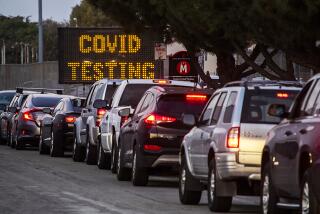PERSONAL HEALTH : More Testing for Pregnancy at Home
- Share via
It’s a question that can drive a woman crazy, whether she plans to be a parent or not. Is she or isn’t she pregnant?
To find out fast, she’s likely to bypass her doctor at first and buy a home pregnancy test. This year, women are expected to spend about $175 million on these kits, more than double 1988 sales, according to industry estimates.
One survey of 144 pregnant women visiting a medical clinic found that 56 had first used a home test, according to a recent report in U.S. Pharmacist, a trade publication.
And why not? Conducting a test in the privacy of one’s bathroom is easier, cheaper and quicker than waiting for a doctor’s appointment.
Home pregnancy tests have improved dramatically over the past few years, manufacturers claim. “They used to be like small chemistry sets,” says Mark Francois, spokesman for the San Diego-based Quidel Corp., which manufactures the Conceive home pregnancy test. Now, many are one-step and some promise results in 60 seconds.
How They Work
With names like First Response and Clearblue Easy, home pregnancy tests can sound more like smoke alarms or cleaning products than parenthood predictors. Despite the jazzy labels and real-life commercials, the home kits work on a simple premise.
The kits check for the presence of a hormone called human chorionic gonadotropin or HCG, which is produced by the developing placenta and found in the blood and urine of pregnant women.
Package instructions often tell the user to collect first morning urine because HCG is most concentrated then. But the later the menstrual period, the less important that is, because HCG levels continue to rise during early pregnancy.
Some tests promise accuracy rates of more than 99% and claim to be able to detect pregnancy as early as one day after a period is due.
Instructions vary, but involve collection of urine and testing it on a test pad or in a container. For instance, with Conceive a woman uses a plastic cup to collect urine. If necessary, she can store the first morning urine for later testing, but it’s preferred to test immediately.
Next, she opens the testing container, being sure the result window is face up. The urine is drawn up in a dropper and placed it in a sample well.
After a one-minute wait, results appear. If a pink test line appears, she is pregnant. If there is only the blue control line, she is not.
Glitches
Many manufacturers maintain toll-free hot lines for consumer questions. At Clearblue Easy, the line is staffed with trained professionals 24 hours a day, says Mina Bender, spokeswoman for American Home Products, the distributor. “Last year, we got 200,000 calls.” When women don’t see the result they want, Bender adds, they often call to see if it could be operator error.
Other manufacturers staff lines during business hours and take messages after hours.
Operator error is sometimes to blame. To minimize the risk, experts advise: Use clean containers and don’t reuse tests. Time the test, don’t guess. Put the equipment on a steady surface so it won’t spill.
In the early days, home pregnancy tests were fraught with problems. Newer tests are “fairly infallible,” says Bender. “Now, the chance of a false negative or (false) positive are minimal.”
But still possible. So, some manufacturers offer twin-packs--just in case you want to confirm the news.
The Numbers, Please
Speed in getting results is cited by more than 40% of women who use the tests, according to Thomas A. Gossel and Michael P. Mahalik, researchers at Ohio Northern University who reported on pregnancy tests recently in U.S. Pharmacist. Confidentiality and convenience are cited as well as saving the cost of an office visit.
Most home pregnancy tests retail for $7-$15. Several offer the double packs at a bargain price or even at two-for-one savings.
Most likely to buy a home pregnancy test, experts find, are married women who are highly educated or have a high family income.
Doctor’s Input
Some physicians used to criticize home pregnancy tests, notes one manufacturer’s spokesman, because they were concerned about accuracy and perhaps losing business. But many doctors these days see a role for them.
The tests have been simplified, thus reducing the chance for mistakes, says Dr. Gerald Bernstein, USC professor of obstetrics and gynecology.
“Any home diagnostic test is liable to abuse,” he allows. “The most important thing is to read the instructions carefully and follow them.”
When used properly, home tests can be very accurate, according to a statement issued in 1990 by the American College of Obstetricians and Gynecologists.
They warn women, though, that “false-negative” results, while uncommon, can occur perhaps 3% of the time.
If you have unusual symptoms after a negative result or your period still does not occur, it’s wise to get a doctor’s opinion.






